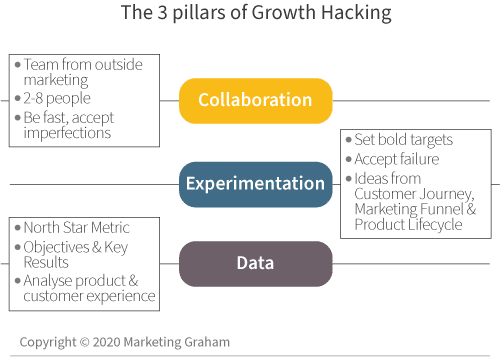Ask 10 different marketing managers “What is B2B growth hacking?” and you’ll get 10 different answers. Well, I’m the 11th marketer, and here is my simple, no-nonsense guide.
First of all, I didn’t know that I’ve been doing Growth Hacking for years until I diluted all the different interpretations into plain English. You may feel the same after reading this post 🙂
Growth Hacking is a process and culture adjustment. Your team conduct rapid testing and analyse data to improve customer and revenue growth. That’s it. It sounds like normal marketing on amphetamines.
The key pillars are collaboration, data and experimentation.
This is a lean and agile approach to growth. It was first developed for start-ups and scale-ups that had ambitious targets but limited resources. The first person to do B2B Growth Hacking was me!! …… OK, the truth is nobody can be sure who created it.
Some suggest it was Sean Ellis at Dropbox. Sean created a culture of experimentation to speed growth. In 2010 he gave this process a name, Growth Hacking.
How do you start B2B Growth Hacking?
You need to build a team and a culture that fosters ideas, testing and cooperation – with everyone feeling comfortable about failure.
The team should include key players outside of the marketing department; product managers/developers, operations, data analysts, sales and possibly more. It can consist of anything from 2 to 8 people.
To accelerate growth your colleagues will need to stop operating in silos. That’s the first step in Growth Hacking.
Next, you will need to encourage rapid experimentation – lots of it. You’ll be testing new ideas (including some crazy ones) right across the customer journey; from changes to the product to how the Customer Service team answer the phone.
Then you need to be seriously data-driven. Capturing and analysing data on all your tests and experiments. Dropping or adjusting the ones that fail (the majority), and implementing and improving the ones that succeed (a few). And doing it all at speed!
The most important metric is often called the North Star Metric.
For example, Airbnb’s North Star Metric is nights booked. Everything they do is driven by improving the number of nights booked.
If Airbnb were driven by the number of app installs, they might get a ton of downloads but very few bookings. As a result, Airbnb would not be maximising revenue, and customers would not be sharing their experiences with friends. It’s nights booked that actually creates value.
Finally, your Growth Hacking team will need to accept they may face opposition, failure, and more challenges than they imagined. They will need a thick skin and determination.
Growth Hacking culture
You need to be bold. Set unreasonable targets – 20% better isn’t enough, you should aim for 20x better! You’ll probably never get 20x, but if you aim for 20x and you get 2x you’ll still be a hero (because it’s better than 20%).
Next, simplify everything. Growth is about being fast. Keep your team small, documenting only what is necessary, hold the minimum number of meetings (thank God). Growth ideas can’t go through a complex review process involving a committee of stakeholders. One person needs the authority to say Yes or No.
Additionally, to move fast, you have to be content with the idea of being ‘close enough’. You can’t always wait for perfection. Try ideas that are ‘ready-ish’. If they show value, you can improve them later.
And finally, always be growing skills – yours and the team. Examine the areas where more practice or education will reduce roadblocks. Try to keep all the skills you need within your team. Importing experts will only cause delay.
Growth Hacking data
Data is at the core of Growth Hacking. It gives you evidence of what’s working and what’s not. Admittedly, this sounds a lot like traditional marketing. The argument is that hacking goes beyond conversion rates, brand mentions, and the number of Likes or Followers.
Growth Hacking data is often centred around the product and customer experience. You’ll be asking questions like “What motivates them to buy?”, “Why did they buy from a competitor?”, and “What online behaviour did they display before purchase?”
At some point in the analysis, you’ll scream Eureka! That moment might hold a dramatic revelation that will result in exponential growth.
There’s a common misconception the growth of brands like Uber and Airbnb was because their idea was brilliant. That’s not true. The idea was the easy part. Their growth was driven by relentlessly capturing data and using it to generate ideas they could then quickly test. That’s Growth Hacking.
Growth Hacking experimentation
With a team in place and an analysis of your existing customers, you can start to identify your goals. Be honest about where you are and clear about where you want to go.
You’ll need to set a North Star Metric and create OKRs (Objectives and Key Results). These will help you monitor your goals. I’ve expanded on these two performance indicators in a blog post titled ‘Growth Hacking; what are marketing OKRs, ICE and North Star Metric?‘.
Next, you generate ideas that can get you to your goal. Those ideas will come through an examination of the customer journey, your marketing funnel, and your product life cycle. It’s best to create a Plan-on-a-Page; a single page document that helps focus your ideas in the right area.
You’ll probably end up with a list of ideas as long as your arm. Now you need to score and prioritise them. A popular scoring method is ICE (Impact, Confidence, and Ease). Again, I’ve covered the subject in more detail in my post ‘Growth Hacking; what are marketing OKRs, ICE and North Star Metric?‘.
From here, you test the ideas. Experimentation (and failure) is at the heart of B2B Growth Hacking. The structured method outlined above gets you from paper to execution much faster.
With the ideas live, you’ll collect the performance data, evaluate it against your growth goal, and then make the next set of decisions.
This becomes a cycle, and you rinse and repeat.
This is scary
First, the growth process works when it’s led by someone who has been granted influence over all the areas of your business. Otherwise, you end up with great ideas that go nowhere.
Second, Growth Hacking is a long-term organisational shift. This is bigger than marketing, everyone needs to be on-board. If your CEO is sceptical you are wasting everyone’s time.
I know what you’re thinking. You’ve seen the vision and the promise, but have your doubts about making this happen at your company. My advice? Start small. Get approval to trial this with a small team on a small area of your business.
Hopefully, as you demonstrate success, you’ll quickly find believers and evangelists to help you make it go viral. Need help? Book a free 1-hour consultation with me. Click the button below.
Photo by The Creative Exchange


